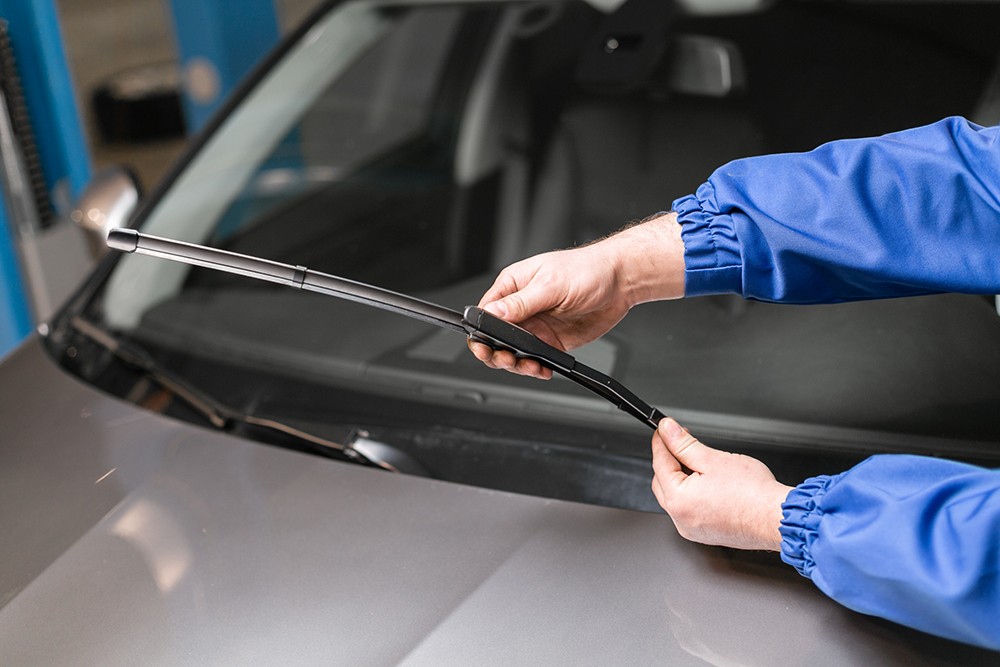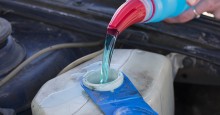
One wiper blade expert has flown more than 80 flights so far this year from Ohio to points throughout North America, preaching wiper blade cognizance and doing some motivational speaking on the side.
Brian Trigalet of ITW Professional Automotive Products realizes he is excessively detailed when it comes to caring for his ride. He treats his 2023 sports utility vehicle like an Indy car and describes himself as “being super attentive to maintenance.”
That also comes down to the kinds of wiper blades he uses for his rig.
“I live in Ohio and we get the full extent of four distinct seasons,” Tringale said as he gazed out his home office window. “Right now, the leaves are turning a gorgeous red.”
The anthocyanin responsible for the stunning amber and scarlet hues also triggers a Pavlovian reaction in Trigalet, who manages a sales channel that includes RainX and Wynns engine products.
His inner voice cannot be ignored, he said. It starts as a suggestion in late September. By early November that tap on his conscience becomes demanding and persistent.
“It’s time to change summer blades to winter blades,” said Trigalet, who visits auto service shops across North America. Part of his job is preaching the importance of wiper blades as routine safety maintenance.
Trigalet earned a degree in hospitality business from Michigan State where he also was an avid athlete and nurtured a golf obsession. He drags his clubs across the country and five times has played the sweeping vistas of Pebble Beach Golf Links.

Growing up in Ohio meant nasty winters and visibility reduced to a few car’s lengths. Slushy snow would freeze on his vehicle’s windshield and become encrusted under the wiper blade assembly. The blades struggled to remove the icy mess and scraped noisily across his SUV’s windshield. He would peer through icy streaks to view the road.
“Visibility is easy to overlook when your vehicle is being serviced,” Trigalet said. “Drivers need to make sure they let their service advisors know about their plans for holiday road trips. That can make a difference in the types of wiper blades you need to help your family stay safe while traveling.”
Trigalet has been caught in storms from Toronto to Houston, from San Francisco to Tampa. He knows firsthand how wiper blades affect visibility and help prevent accidents in all kinds of weather.
Whenever he visits auto repair facilities, Trigalet shares his wealth of knowledge about windshield safety with service advisors and customers alike. He explains how something as simple as wiper blades can help dramatically improve visibility in all kinds of weather.
Living in Texas for 15 years meant hot, humid summers. Extreme heat can turn rubber wipers soft and drag them across the glass surface fitfully. Damaged blades are not as effective much when drivers encounter the inevitable summer rainstorms.
Visiting Florida gave Trigalet an appreciation for winds so strong wiper blades lifted off the surface of the windshield.

“Some wiper blades can act like an airplane wing,” Trigalet said, who suggested drivers purchase blades for the environment where they live or visit. “The wiper blade market has moved strongly toward specialty products.”
For instance, drivers can invest in blades designed to stay pliable but strong in climates with ice and snow. Or they can get blades treated with water repellent to help them efficiently sweep away rain in heavy downpours.
Silicone blades last longer and perform better than traditional rubber blades on those hot summer days. Large trucks and vans can benefit from heavy duty blades for large vertical windows and frequent freeway driving.
Wiper blades engineering
Conventional wiper blades usually are the most affordable type of products and suited to Mediterranean climates. They use a rubber blade attached to metal claws that connect to a metal spine.
The conventional rubber design has more limitations for drivers going to different types of climates, however. They tend to wear out faster in cold and hot climates. Also, the UV rays of the sun and ozone makes them brittle and less effective.
All-rubber blades get stiff in cold weather and may start chattering–a noise Trigalet admits can create a bit of wheel gripping anxiety he drives through ice storms.
“Can’t stand it,” Trigalet said. “The noise, the smears, the streaks. Wiper blades are safety equipment that must not be overlooked.”

Beam blades are a style of wiper not attached to a metal frame. The design allows the wipers to be more flexible and curve better to your windshield.
Since they have good contact on the glass, beam blades are effective at displacing heavy rain. Also, beam wiper blades have a lower profile that cuts down on this wind lift and ensures better surface contact as you drive through storms.
Hybrid styles of blades combine features of conventional and beam blades. They have a sturdy, long metal spine and a flexible rubber sweep. They are lightweight like beams and designed for all weather conditions including ice and snow. The metal spine gives them a bit more sturdiness while maintaining contact with curved window surfaces found on most new SUVs and sedans.
Tips for choosing and caring for wiper blades
“There is a significant difference in quality depending on brand and price,” Trigalet explained. “Invest in quality wiper blades that offer specific rain benefits or are designed to sweep away frost and snow. They’ll last longer and perform better.”
Trigalet offered the following tips for selecting and maintaining wiper blades:
- Do your wiper blades rub, scrape or vibrate as the arm moves across your windshield? Once the thin rubber blade has worn down, metal claws on conventional wiper blades can etch lines into the windshield. Replace wiper blades before the wiper assembly causes permanent damage to your vehicle windshield.
- Do your vehicle’s wiper blades cause streaks? The problem usually indicates poor contact between the wiper blade and glass surface. A beam blade can solve the problem.
- What causes deterioration of wiper blades? Intense summer sun hardens and cracks rubber compounds in blades. Vehicles left outside are particularly susceptible to deleterious effects of the sun’s UV rays.
- How often should wiper blades be replaced? Frequent use in winter and scraping across frost-covered windshield accelerates wear on the blade edge. Some blades have a UV indicator that lets you know when they need to be changed. Manufacturers such as RainX recommend replacing wiper blades every six months or sooner if you notice they are not maintaining windshield visibility.
- Invest in a second pair of wiper blades. Use one for winter and a second for the other three seasons. If you live in a Mediterranean climate, Trigalet recommends keeping a pair of winter blades in your vehicle trunk to install when traveling to ski resorts or cold environments.
- What about rear wiper blades on SUVs? On most modern vehicles, windshield blades get tucked under the hood when not in use. Not so with rear blades. They are exposed to hot sun as well as freezing conditions, and they tend to wear out quickly. Trigalet changes out his rear SUV blades twice a year to prevent smearing and streaks.
- What kinds of blades provide the best wear? Silicone or synthetic blends are a good alternative to all-rubber blades. Blades containing synthetic compounds remain pliable in cold weather. All-rubber blades tend to get gooey in intense heat and harden in freezing temperatures but work fine in Mediterranean climates.
- What size of replacement blades do you need? Wiper blades are specific to your vehicle. Some vehicles have two different sizes of blades for the windshield. SUVs have a different size of blade for front windshield and rear window. You can find the right sizes in your owner's manual or simply ask your service advisor.
- What type and style of blades should you use?
- Winter wiper blades are constructed of thick rubber to sweep away snow and ice.
- Beam blades are well-suited to locations with lots of rain and windy conditions. They don’t attach a metal frame, so they’re more flexible and shape to the curve of your windshield.
- Heavy duty blades are designed for vans and commercial vehicles to take the brunt of ice, snow, rain and insects splattering into vertical windshields.
- Rain repellent blades provide less friction and sweep away moisture efficiently.
- Rugged blades may be used for off-roading to handle the mud and grime encountered on backcountry trails.
- Acoustic blades help reduce annoying blade noise for a quieter cabin.
- Blades with a UV indicator let you know when it’s time to replace worn out wipers.
- Extend life, performance of wiper blades by keeping them clean. Leaves, small pieces of limbs or insects can get stuck on the blade. Use a terry cloth or microfiber towel and quick detailer spray to remove debris.
- Watch for rust spots on metal parts, which indicate the assembly may fail.
- Use a terry cloth or microfiber towel to wipe away debris, bug goo, sap and other contaminants that stick to the blade and keep it from performing properly.
- Keep your windshield glass clean of debris and contaminants that can damage blades as they sweep across the glass. Use a window cleaner designed for automobile glass to prevent streaks and avoid damage to window tint film.
- Spray your windshield and rear window with a rain repellent to improve visibility and help prevent beads of water from drying on surfaces. Rain repellent also helps wiper blades glide easier across the glass surface.
“Consider wiper blades as a winter safety technology that must not be overlooked,” Trigalet said.
“Install them before your upcoming ski vacation or road trip. You don’t want to spend time driving around for a new set of wiper blades when you could be enjoying time away with friends.”
Article by Jay Alling, editor of Sensible Driver. Write to jay@sensibledriver.com.
Copyright © 2024 by Sensible Driver. All rights reserved.